Area: History, Design Technology (DT) and Math
Grade Level: Lower primary level
Course: Multidisciplinary Lesson
Timeframe: 45 minutes – 1 hour
Lesson Overview
Hands on fun DT activity which will engage children in applying what they already know about the Great Fire of London into a moving scene. During this activity children use fine motor skills to draw and colour buildings from 1666, cut, fold and hole punch card and insert fasteners. This activity invites DT and history questions from children. These scenes can be played with and used as a writing prompt.
Objectives
Upon completion of this Lesson students will be able to:
- Design Technology: fold and cut paper and card, cut along lines, straight and curved, use a hole punch, insert paper fasteners for card
- History: use secondary source material to find out about an event
- Math: use measurements for materials
Material/ resources
This lesson works with a full class (20-30 children) inside a classroom. It is a hands on practical activity.
- 1 Pencil (1 per child)
- Coloured pencils / crayons (to share)
- A5 white card (1 per child and extra for lever)
- Scissors (to share)
- Split pins (1 per child)
- Hole punch (to share)
- Images depicting the Great Fire of London (either to show to the whole class or a selection to pass around the individual groups)
- Interactive White Board (IWB) or printed copies of images
- Red, yellow, orange tissue paper or coloured paper (several sheets per group)
Lesson activities
- Introduction to the scenario and activity (15 minutes)
- Start by showing an image or short video (provided) about the Great Fire of London and explain the basic story of the event.
http://www.fireoflondon.org.uk/collection-type/artworks
https://www.bbc.co.uk/newsround/37253904
https://www.bbc.co.uk/newsround/37253903 - With the images of the fire on display discuss what we know happened during the Great Fire of London. You can prompt the discussion with questions such as
What material are the houses made of?
What colour might the houses have been?
Describe how the houses have been built?
Are the houses close together or far apart?
How do you think this contributed to the spread of the fire?
How do we know all this? - If necessary, show some more images until the children have built up a clear understanding of the buildings appearance and layout (tall, close together, wooden).
- Start by showing an image or short video (provided) about the Great Fire of London and explain the basic story of the event.
- Create a simple diorama of a scene from the Fire of London (20 – 30 minutes)
- Each student will make their own diorama provide the necessary materials for the activity.
- Model how children are to draw a row of houses themselves on cardboard (you may have pre-prepared examples ready to show each group)
Step-by-step instructions for learners
- Students should use the houses in the pictures as inspiration for drawing a row of houses on their piece of cardboard.
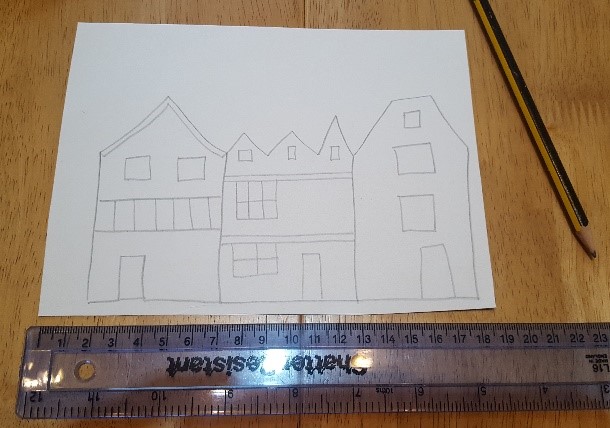
- Colour the buildings
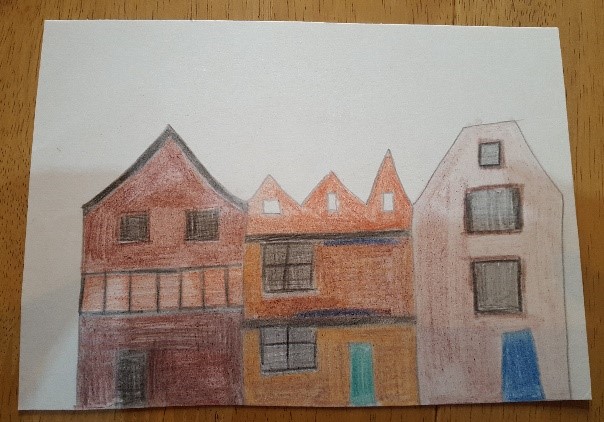
- Cut along the rooftop skyline
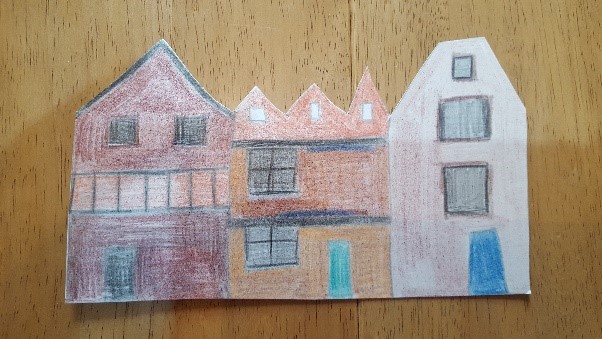
- The students should now use a new piece of cardboard and fold a strip of cardboard (approx. 2cm wide) and cut along the fold. Students should use a ruler (or compare length) to ensure their strip of cardboard is longer than the line of houses.
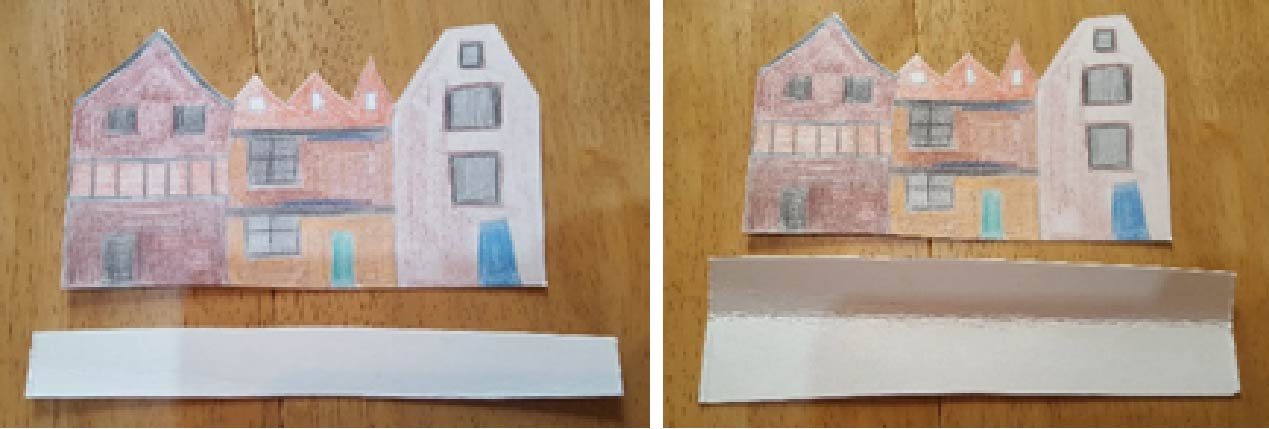
- Create a flame effect at one end of the cardboard strip with the coloured paper/tissue paper and crayons.
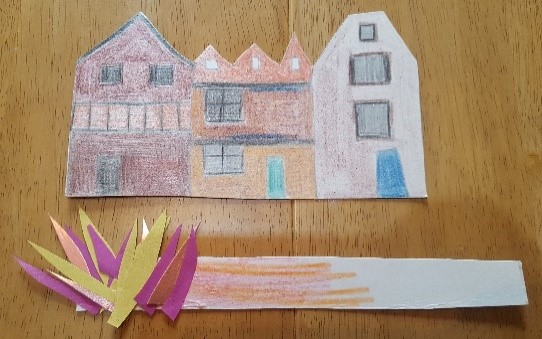
- Use a hole punch to put a hole at any point of the image.
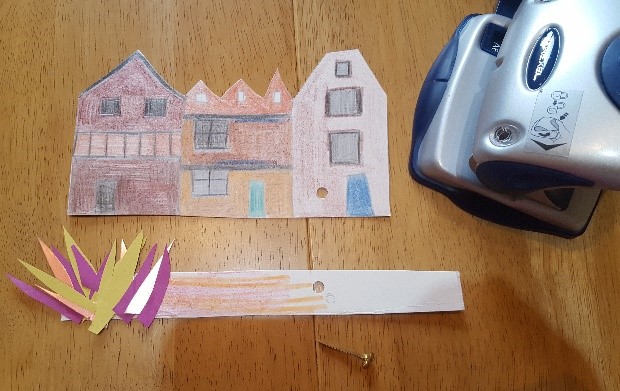
- The flames need to pivot up above the houses from the hole punch point and another hole put into the cardboard strip. This may take some experimentation to ensure the hole is punched in the best location for the flames to appear above the houses.
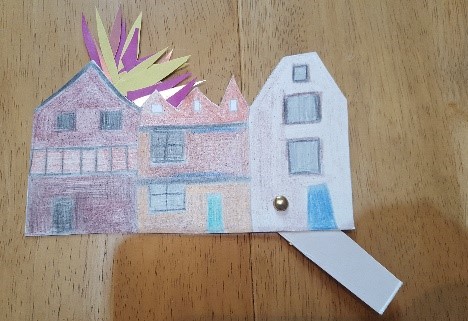
Final assessment and discussion (10 minutes)
- Once all of the groups have completed their dioramas then each group should go around the class and look at the other group’s dioramas.
- After this, a full class discussion should take place about the activity and the Great Fire of London, you may ask them about how modern-day cities are built differently to reduce the chances of such an event happening again.
Instructions for teachers
Prior knowledge of the Great Fire of London
This lesson works best if the students have some prior knowledge of the Great Fire of London. The children can gain an understanding of the Great Fire of London by watching the videos provided.
Differentiation
This activity can be differentiated by outcome.
Additional assessment of knowledge
You may add an element of assessment of historic understanding through open and closed questioning and application of knowledge i.e.
- What material are the houses made of?
- How do we know this?
- What colour might you colour your houses?
- Describe how the houses have been built?
- Are the house close together or far apart?
- How do you think this contributed to the fire?
Assessment of DT skills through observation of children completing the activity, the amount of support required, and their understanding of instructions given:
- Student feedback during activity
- Guidance provided verbally throughout the lesson